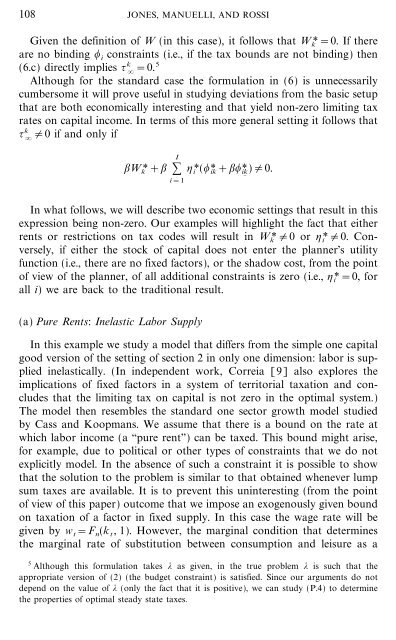On the Optimal Taxation of Capital Income
On the Optimal Taxation of Capital Income
On the Optimal Taxation of Capital Income
Create successful ePaper yourself
Turn your PDF publications into a flip-book with our unique Google optimized e-Paper software.
108 JONES, MANUELLI, AND ROSSI<br />
Given <strong>the</strong> definition <strong>of</strong> W (in this case), it follows that W k*=0. If <strong>the</strong>re<br />
are no binding , i constraints (i.e., if <strong>the</strong> tax bounds are not binding) <strong>the</strong>n<br />
(6.c) directly implies { k =0. 5<br />
Although for <strong>the</strong> standard case <strong>the</strong> formulation in (6) is unnecessarily<br />
cumbersome it will prove useful in studying deviations from <strong>the</strong> basic setup<br />
that are both economically interesting and that yield non-zero limiting tax<br />
rates on capital income. In terms <strong>of</strong> this more general setting it follows that<br />
{ k {0 if and only if<br />
I<br />
;Wk*+; :<br />
i=1<br />
' i*(,* ik+;,* ik){0.<br />
In what follows, we will describe two economic settings that result in this<br />
expression being non-zero. Our examples will highlight <strong>the</strong> fact that ei<strong>the</strong>r<br />
rents or restrictions on tax codes will result in W k*{0 or ' i*{0. Conversely,<br />
if ei<strong>the</strong>r <strong>the</strong> stock <strong>of</strong> capital does not enter <strong>the</strong> planner's utility<br />
function (i.e., <strong>the</strong>re are no fixed factors), or <strong>the</strong> shadow cost, from <strong>the</strong> point<br />
<strong>of</strong> view <strong>of</strong> <strong>the</strong> planner, <strong>of</strong> all additional constraints is zero (i.e., ' i*=0, for<br />
all i) we are back to <strong>the</strong> traditional result.<br />
(a) Pure Rents: Inelastic Labor Supply<br />
In this example we study a model that differs from <strong>the</strong> simple one capital<br />
good version <strong>of</strong> <strong>the</strong> setting <strong>of</strong> section 2 in only one dimension: labor is supplied<br />
inelastically. (In independent work, Correia [9] also explores <strong>the</strong><br />
implications <strong>of</strong> fixed factors in a system <strong>of</strong> territorial taxation and concludes<br />
that <strong>the</strong> limiting tax on capital is not zero in <strong>the</strong> optimal system.)<br />
The model <strong>the</strong>n resembles <strong>the</strong> standard one sector growth model studied<br />
by Cass and Koopmans. We assume that <strong>the</strong>re is a bound on <strong>the</strong> rate at<br />
which labor income (a ``pure rent'') can be taxed. This bound might arise,<br />
for example, due to political or o<strong>the</strong>r types <strong>of</strong> constraints that we do not<br />
explicitly model. In <strong>the</strong> absence <strong>of</strong> such a constraint it is possible to show<br />
that <strong>the</strong> solution to <strong>the</strong> problem is similar to that obtained whenever lump<br />
sum taxes are available. It is to prevent this uninteresting (from <strong>the</strong> point<br />
<strong>of</strong> view <strong>of</strong> this paper) outcome that we impose an exogenously given bound<br />
on taxation <strong>of</strong> a factor in fixed supply. In this case <strong>the</strong> wage rate will be<br />
given by w t=F n(k t, 1). However, <strong>the</strong> marginal condition that determines<br />
<strong>the</strong> marginal rate <strong>of</strong> substitution between consumption and leisure as a<br />
5 Although this formulation takes * as given, in <strong>the</strong> true problem * is such that <strong>the</strong><br />
appropriate version <strong>of</strong> (2) (<strong>the</strong> budget constraint) is satisfied. Since our arguments do not<br />
depend on <strong>the</strong> value <strong>of</strong> * (only <strong>the</strong> fact that it is positive), we can study (P.4) to determine<br />
<strong>the</strong> properties <strong>of</strong> optimal steady state taxes.
















